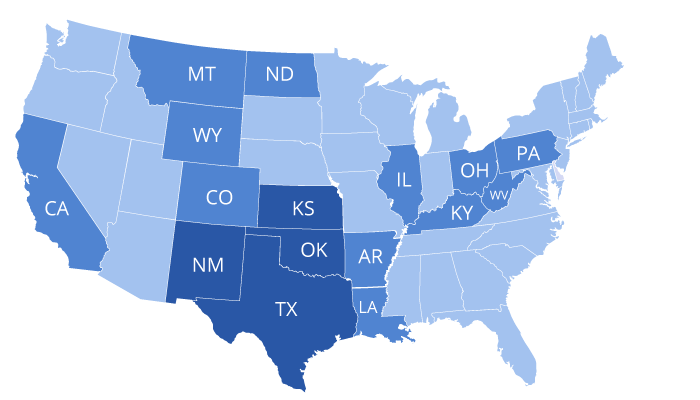A QUICK GUIDE TO
Oil & Gas Division Orders
Learn what a division order is, why it matters, and how to verify your ownership for accurate royalty payments.
Sell Your Mineral Rights (Request an Offer):
Understand What You Are Signing
Overview of Oil and Gas Division Orders
A division order is simply an agreement between you and the company that operates an oil or gas well, ensuring all parties are on the same page about what you own and how you should be paid.
When are division orders issued?
Division orders are sent when a new well is drilled or there is a change in ownership.
Do I have to sign a division order?
Some states, like Texas, require signed division orders before sending royalty payments. Other states, such as Oklahoma and North Dakota, do not mandate division orders. Regardless of state, division orders are commonly used to ensure accurate royalty distributions.
NADOA Model Form
The division order in this example is the National Association of Division Order Analysts (NADOA) Model Form.
The company that operates the well (or pays your royalties) will send you their division order. Soemtimes, theirs matched the NADOA model form, but it may also be a very different form. Be sue you read the terms and if you don’t like the terms, consider sending a NADOA form (not all operators will accept them, but most will).
Getting Into Pay Status
Oil & Gas Division Orders: A Brief Overview
Learn about oil and gas division orders, what they are for, and why it’s so important to check for accuracy and understand the terms of the agreement. We’ll go over the two most common pitfalls and recommend a solution if you run into problems.
Parts of Oil and Gas Division Order
Let’s break down the parts of a division order so you have a better understanding of each section.

Property Info
The top of the division order lists the well information including the number, name, operator, location, and type of product produced.

Effective Date
Each division order will have a space for the effective date. The effective date may be months or years in the past, depending on the situation. Or, it could be very recent.

Owner Information
There will always be a section that lists the over information, which may include the owner number, name, contact info, type of interest, and decimal (or net revenue) interest.

Terms of Agreement
The terms of the agreement usually contain the payor’s name, how disputes, ownership changes, minimum payouts will be handled, and other terms.

Signatures
Division orders must be signed by the owner and in many cases, the owner’s signature must be witnessed. The tax ID (or social security number) will be used to send you a 1099 each year so that you can report your royalty revenue to theIRS.

W9 Reminder
The bottom of some division orders will contain a reminder to submit an IRS Form W9 with the division order. The operator is required to send you a 1099, and you are responsible for paying taxes on your royalty revenue. If you do not send a W9, some operators will withhold 24% of your royalty income and others may not pay you until the W9 is received.
We Make it Easy
Three-Step Process
There are three steps to transferring the ownership of oil and gas royalties and mineral rights. Producing minerals will need to follow all three steps, but non-producing minerals only need the first two steps. Depending on the situation (death, divorce, trust, etc), the requirements may differ slightly).
1. Verify Accuracy
It is really important that all of the information on the division order is correct! If you inherited the mineral rights, you can check to ensure well information, interest type, and amount match the previous owner.
2. Sign Division Orders
If everything looks correct, sign the division order and, if required, have your signature witnessed by an disinterested third party.
4. Return the DO and a W9
Send the signed division order back to the operator (by mail or email) along with a signed IRS Form W9. (for tax reporting purposes)
How to Calculate Interest
It can be challenging to calculate your interest in a given oil or gas well. In many areas, the calculation is simple:
Net Mineral Acres Owned ÷ Total Acres in the Unit or Tract × Royalty Rate × Your Lease Interest
To perform this calculation, you need to know:
-
- Number of net mineral acres (not gross acres – this may be hard to find without a landman).
- Total acres in the drilling unit (available from the state’s regulatory agency)
- Royalty reservation (specified in your lease)
- Check for proportional lease interest (you are probably not the only mineral owner)
However, if you have a horizontal well in Texas, you might have an allocation well, which is a more complex calculation.
What if I don’t know enough?
You can hire a landman to help you find this information and ensure the division order is correct.
Or, you can take a risk and blindly sign the division order, which is a risk.

Frequently Asked Questions (FAQ)
What happens if I do not sign the division order?
What happens if you don’t sign your division order depends on the state where the well is located. If the well is in Texas and you do not return your division orders, you will not be paid royalties.
In Oklahoma or North Dakota, where division orders are not mandated, you will likely be paid regardless of whether you sign the DO.
If you are not sure if division orders are required and are uncomfortable signing one, you can ask the operator (or an attorney) if you must sign and return the division order in order to be paid.
What happens if I do not sign the division order?
What happens if you don’t sign your division order depends on the state where the well is located. If the well is in Texas and you do not return your division orders, you will not be paid royalties.
In Oklahoma or North Dakota, where division orders are not mandated, you will likely be paid royalties regardless.
In other states, you can ask the operator (or an attorney) if you must sign and return the division order in order to be paid.
What if I sign the division order but don't know if it's accurate.
Signing a division order without ensuring accuracy may create financial and legal problems.
If you own more interest than stipulated on the division order, you might be paid less than you deserve.
On the other hand, if interest in the division order is higher than you own, you will be overpaid. Once the error is discovered, they may garnish your royalties to correct the issue.
The terms of your division order may include legal language that puts you in a bad position if any of the information is inaccurate or if you are overpaid. It’s best to make sure the division order is correct before you sign it. A division order is a legal document.
I just inherited mineral rights. Where do I find help?
Being a new mineral owner can feel like drinking from a fire hose. There is a lot to learn, but you don’t have to do this alone.
Three options for help (or escape):
- Hire a landman to help you understand what you own.
- Outsource mineral management to a professional manager (this only makes sense if you earn significant royalties).
- Learn independently by reading books, watching YouTube videos, and talking with other mineral owners (NARO is a good resource).
- Sell your mineral rights so you don’t have to deal with them (contact us for an offer).
Why did I get paid on new wells without signing a division order?
If you are being paid royalty revenue and didn’t sign a division order, it might be because division orders are not mandated in your state or because you already signed a division order for other wells on the same lease, and the operator has decided to pay you without a signed DO for this specific well.
What is a Transfer Order?
A division order is sometimes referred to as a transfer order.
A division order is only signed by the current owner of the mineral rights. Some operators require a transfer order, which usually requires the signature of both current and previous owners (probably to prevent fraud). Transfer owners are not as common as division orders but serve the same purpose.
How do I calculate my decimal interest or net revenue interest?
Most of the time, your decimal interest (also called net revenue interest) is calculated with the formula:
Net Mineral Acres Owned ÷ Total Acres in the Unit or Tract × Royalty Rate × Your Lease Interest
However, if you have an allocation well in Texas, the formula is more complex:
(Total Acres in TractNet Mineral Acres Owned in Tract × Royalty Rate×Your Lease Interest) × Tract Allocation Percentage
I don't like the terms on my division order. What are my options?
If you don’t like the terms of your division order, you may be able to send a NADOA model form, which has industry-standard language. Most operators will accept the NADOA form, but some do not. It’s usually worth a try!
If the operator will not let you sign an NADOA form, you may want to contact your attorney for legal advice.
Some operators sneak in language that modifies your oil and gas lease. Watch out for language that allows the operator to take deductions, which reduces your royalty revenue.
National Focus
Where We Buy Mineral Rights
We buy both producing and non-producing minerals in all oil and gas states. However, we are especially interested in Texas and Kansas mineral rights.
|
We even buy minerals in more obscure states, which produce very little oil and gas compared to other states.

Why Sell?
Why People Sell Their Mineral Rights
I am putting my affairs in order. I don’t want to burden my kids with the hassle of transferring ownership and managing small mineral rights. When my sister passed away, my niece and nephew had to hire an attorney to help them with the minerals. I don’t want my kids to go through that.
I inherited my mineral rights so they were sentimental, but I don’t really want to bother with managing them and filing extra tax returns. I decided to sell and use the money as a down payment on my house.
I had no idea how fast the oil production would decline. My checks are only 20% of what they were a few years ago. I should have sold my mineral rights when the wells were brand new and still generating huge royalties.
My oil wells have been producing for decades and the reserves are almost depleted. Once the wells are plugged, the value will be significantly lower. I’d rather cash out now.
I inherited mineral rights, but don’t want to be involved with fracking and fossil fuels. I would prefer to support renewable energy and do my part to reverse climate change.

